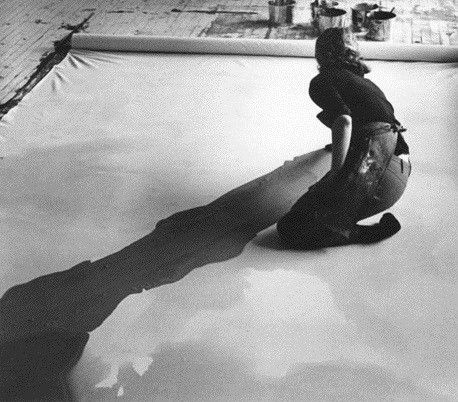Helen Frankenthaler Dead at 83: 'Mountains and Sea' Painter Succumbs After 'Long Illness'

American abstract expressionist painter Helen Frankenthaler died Tuesday at her home in Darien, Conn. Maureen St. Onge, Frankenthaler's assistant, said she died after a long illness but offered no further details. Frankenthaler was 83.
Frankenthaler was a highly influential and highly celebrated artist, receiving the National Medal of Arts in 2001. She also worked with the National Council of the National Endowment for the arts from 1985 to 1992.
Frankenthaler was born in New York's Upper East Side on Dec. 12, 1928, and attended school at Vermont's Bennington College. She later returned to New York to study at Columbia University, taking classes with contemporary painters Vaclav Vytlacil and Hans Hofmann. She was only 22 when she enjoyed her first solo exhibition at the Tibor de Nagy Gallery in New York. She would later attend international shows like Venice's International Biennial of Art.
Frankenthaler was known for a technique that involved staining pigment directly into the raw canvas, a little move she picked up from Jackson Pollock, but going a step further and washing the canvas with paint thinned out by turpentine, which made it look as if the paint was one with the canvas fabric.
What evolved for me had to do with pouring paint and staining paint, Frankenthaler said. It's a kind of marrying the paint into the woof and weave of the canvas itself, so that they become one and the same.
She became very famous for this soak stain technique, which helped launch the next generation of the Color Field school of painting, inspiring artists like Kenneth Noland and Morris Louis.
Very few artists are able to develop a vocabulary and create an aesthetic that affects other artists deeply, said Clifford Ross, a multimedia artist and Frankenthaler's nephew. She was the one who transmitted a certain kind of freedom and boldness use of the subconscious and impulse from the Abstract Expressionists on through the Color Field painters.
One of Frankenthaler's most famous works was Mountains and Sea, which she painted in 1952 using this soak stain technique.
The poured-paint technique had been pioneered by Jackson Pollock a few years earlier, but in this work the 24-year-old Frankenthaler made it her own, said Eric Gibson, a New York Times writer. In place of the older artist's looping and whipping lines of gray, black and tan, her imagery consisted of spreading pools and washes of luxuriant pinks, blues and greens nudged here and there with a sponge. The painting was a revelation to [Noland and Louis]-a 'bridge between Pollock and what was possible,' Louis later said.
Frankenthaler became an inspiration in a time when nearly all of the major players in the art world were male.
Art was an extremely macho business, said Ann Temkin, chief curator at the Museum of Modern Art in New York. For me, there's a great deal of admiration just in the courage and the vision that she brought to what she did.
While Frankenthaler did not align herself with the feminist movement, she was still recognized by her contemporaries as one of the best abstract expressionists, male or female, of her time.
Frankenthaler derived her inspiration from Pollack and Clement Greenberg, an influential art critic with whom she enjoyed a five-year relationship. But most of all, Frankenthaler focused on finding the soul within art and displaying that emotion in the simplest way possible.
I often look at an old master not in terms of its subject matter, but of the placement of color and line, Frankenthaler said in a 1989 interview with NPR. And as an artist, not as a critic or a writer, I want to get at why - what's making this work? If I were doing this picture, what would I be doing? What would I be feeling? I often say I would be swiping this color, or I'm swiping the placement of these colors on the surface of my picture.
Beyond her role as an artist, Frankenthaler was secondarily known as an entertainer. After she married fellow abstract expressionist painter Robert Motherwell in 1958, Frankenthaler loved to throw lavish dinner parties and get-togethers. In 1985, Frankenthaler attended a White House dinner to honor the Prince and Princess of Wales and found herself on the dance floor high-stepping with Mr. Saturday Night Fever himself, John Travolta.
Frankenthaler later divorced Motherwell in 1971 and remarried in 1994 to Stephen DuBrul Jr., an investment banker. She is survived by two stepdaughters and six nieces and nephews.
© Copyright IBTimes 2025. All rights reserved.






















